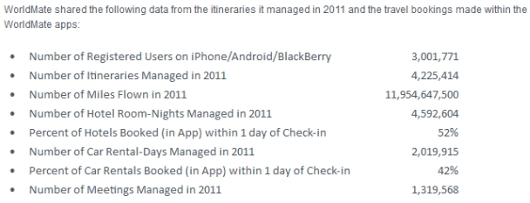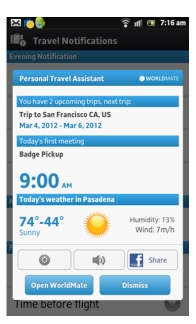What Makes A Mobile Travel App Click
IN-DEPTH: If the mobile app is expected to become core to your business, build an in-house team to create and nurture the app. Outsourcing will get your product to market quicker, but you’ll end up making faulty conclusions, alienating the market, and just delaying the inevitable, says Ian Berman, VP, Business Development, WorldMate.
WorldMate recently won the Best Mobile Travel App Award at EyeForTravel’s Social Media and Mobile Strategies for Travel 2012 conference in San Francisco.
By Ritesh Gupta
The ownership associated with a mobile app is considered to be stronger vis-à-vis a mobile site. Travel companies acknowledge that an app almost has to earn its right to get installed and stay there.
It is recommended that app must depict and make it obvious what can be done with it.
There are companies that have assiduously embraced mobile uniqueness and successfully worked on a differentiated offering.
WorldMate is one of the travel companies today that stand out for their mobile apps. The company, which recently won the Best Mobile Travel App Award at EyeForTravel’s Social Media and Mobile Strategies for Travel 2012 conference in San Francisco, has served over nine million business and leisure travellers by managing their itineraries and then guiding them through every aspect of their trips. Its users flew nearly 12 billion miles in 2011.
The company believes it scores in this arena owing to its unique approach in building the contextual profiles of its users and then proactively serving them with personalised recommendations for hotel rooms and car rentals.

WorldMate’s patent pending TripCatch technology automatically recognises travel confirmations as they arrive in the traveller’s smartphone’s email inbox. It then collates the flights, hotels, car rentals, and train reservations into a comprehensive travel itinerary, which serves as the basis for determining the traveller’s context.
Over time, as WorldMate aggregates more itineraries from each of its users, that contextual profile of the traveller evolves to the point where WorldMate recognises if a user is missing an accommodation and then recommends hotels that best match that traveller’s preferences while taking into account the specific logistics of his or her upcoming trip. The hotels and car rentals are booked in WorldMate with a few clicks of the button since travellers’ payment details are also stored within their profile.

The company this year also introduced its Price Alerts service. This service automatically reviews every hotel reservation in WorldMate’s millions of itineraries and then sends a discounted offer to the traveller for the same room or presents a counter offer for a similar but less expensive hotel nearby.
Maturity Level
Assessing the maturity level of mobile offerings at this juncture, Ian Berman, VP, Business Development, WorldMate says the level is varied depending on the app in question.
“Generally, we see more mature offerings from companies that are pure-play mobile that we do from the big brands and Web 2.0 services which are attempting to “port” their offerings to mobile. This holds true even if the pure-play mobile developer is much younger than the big brand/Web 2.0 company. It is very much like the success we saw the .com’s had in the early days of the online travel services versus the well-established traditional travel agencies and suppliers,” Berman told EyeforTravel.com’s Ritesh Gupta in an interview.
Due to the mass proliferation of smartphones and tablets, the outlook of mobile apps has skyrocketed over the past couple of years.
Travel, by definition, is about mobility and it only stands to reason that smartphones and tablets will usher in the next wave of innovation in this industry, said Berman.
From utility perspective, Berman said the industry isstill in the early days of mobile marketing— there’s more hype than substance.
“With regards to commerce, however, we’re already seeing good traction. In Japan, travel sellers are doing about 20 percentof their bookings on phones. In the US, it is in the 5-15 percentrange (if oneincludestablets) and that number will only grow. Last-second hotel bookings, ground transportation, and local activities andevents will all emerge as dominant m-commerce categories,” he said.
Working on a mobile app
Too many apps are still virtual carbon copies of their corresponding websites, with no attention to the subtleties of how users interact with their phones.
Apps can be hard to use. It is pointed out that apps are designed for features, not for solving users’ real problems; people try too hard to re-use code from the web or other apps; there is not enough testing, both by developers and real users. It is recommended that app must depict and make it obvious what can be done with it.
Berman says for companies that have been only offering PC web-based services, they must take a clean-sheet approach to designing an app.
“Don’t simply try to shrink your web solution to fit on a phone’s screen. Think carefully about how users need different things when they are at their desk vs. on the go. These are very different use cases that require different kinds of services that are delivered in unique ways,” said Berman.
“If the mobile app is expected to become core to your business, build an in-house team to create and nurture the app. Outsourcing will get your product to market quicker, but you’ll end up making faulty conclusions, alienating the market, and just delaying the inevitable,” said Berman.
It is also important to assess how should one set realistic goals and also go about measurement and analytics.
“Don’t spend too much time pre-determining goals,” recommends Berman.
“Think like a start-up. Launch as early as feasible with the core set of functionality and continue to iterate and improve over time. The key metrics will soon become self-evident,” said Berman.
Finally, when it comes to making the most of investments in this arena in 2012, Berman said, “As John Wooden used to say “hurry, but don’t rush”. Invest in a small in-house team, quickly launch a subset of the total vision for the app, and then iterate. Don’t waste months in grand, internal debate and strategy/product planning…and then rush to market with a v1.0 that tries to deliver fully upon that product vision.”

